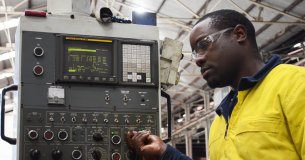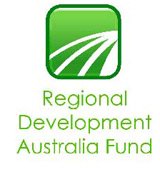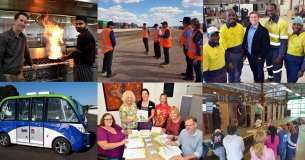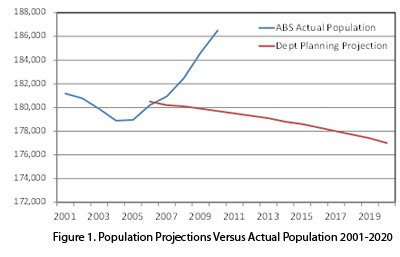-
Featured Items
-
Featured Resources
 Funding & Grants
Don't miss out on funding opportunities. Stay informed with our up to date online listings and email notifications.
Read More
Funding & Grants
Don't miss out on funding opportunities. Stay informed with our up to date online listings and email notifications.
Read More
 Skilled Migration
Our services help both applicants and employers, to learn more, develop plans, submit applications, and settle in.
Read More
Skilled Migration
Our services help both applicants and employers, to learn more, develop plans, submit applications, and settle in.
Read More
 Research and Analysis
Good research and analysis makes the case. How can our resources and services help your project or application?
Read More
Research and Analysis
Good research and analysis makes the case. How can our resources and services help your project or application?
Read More
 Information & Data Resources
With resources like REMPLAN, Regional Knowledge Base, and decades of data, discover how we can help your project.
Read More
Information & Data Resources
With resources like REMPLAN, Regional Knowledge Base, and decades of data, discover how we can help your project.
Read More
-
Stay InformedSubscribe to one or more of our regular email subscriptions, to be kept up to date on news and funding opportunities for the region
-
-
Our Region
- Our Region
- Regional Plan
- Regional Data
- Current Regional Issues
- Population Migration Analysis for 2016-21
- Job Vacancies Continue at All-Time High
- National Debt - What it Means for Our Economy?
- The True Value of Home Solar
- The Economic Impacts of Local Government Amalgamations
- State of the Regions Report 2014-15
- Antifragility - A different take on regional economic development
- Biohubs - Collaborative Waste Management
- Attracting New Residents
- Socio-Economic Impacts of the Murray Darling Basin Plan
- Murray Darling Basin Water Recovery
- Growing Businesses
- The Northern Inland Economy
- Geographical Overview
- Major Industry Sections
- Our Services
- Grants and Funding
-
Skilled Migration
- Skilled Migration
- Skilled Employer Sponsored Regional Visa
- Skilled Work Regional Visa (subclass 491)
- Temporary Seasonal Workers
- Designated Area Migration Agreement (DAMA)
- Helpful Information for Visa Holders
- Information for Employers
- Case Studies
- Payment Details
- Advice & Further Information
- Contact Details
- News & Events
-
Our Projects
- Our Projects
- Current Projects
- Skilled Migration
- Wool Works - Wool Training Schools
- Metal Works - Welding and Fabrication Schools
- Come On Inland
- Stories of Resilience
- Alt Brothers Beekeeping - Glen Innes
- Carelle's Toy Store - Glen Innes
- Greenhill Orchards - Arding
- Gwydir Meats - Warialda
- Kaputar Motors - Narrabri
- Moonbi General Store - Moonbi
- Sandstock - Tingha
- Sherelle Fashions - Tenterfield
- Sleepy Merino - Inverell
- Tenterfield Chamber of Toursim, Industry and Business - Tenterfeild
- The Welders Dog - Armidale
- Walcha Veterinary Supplies - Walcha
- AGCAP - Agribusiness Careers & Professions
- Northern Inland Regional Investment Profile
- Past Projects
- Digital Economy Strategy
- Business Growth Project
- Go Digital
- How to Start an Online Business
- Create Your Website Using Squarespace
- How to Edit Your Squarespace Site - Part 1
- How to Edit Your Squarespace Site Part 2
- Add a Shop to Your Squarespace Site
- Start a Blog and Find out What Customers are Searching
- 14 Tips For a Better Blog Post
- Which Social Media Platforms are Best for Your Business
- How to Use Facebook Effectively For Your Business – Part 1
- How to Use Facebook Effectively For Your Business – Part 2
- Instagram Tips for Business
- Catching Up, More Instagram & Dealing with Haters
- Getting Started with Twitter for Business
- Social Media Scheduling Tools
- How to Start an Etsy Shop – Part 1 – Research
- How to Start an Etsy Shop – Part 2 – Signup
- Online Security for Your Business
- Product Photography and Website Images: Your Guide
- 5 Tips to Improve your Productivity in your Business
- Best Online Business Resources
- How to Improve Your Communication Skills and Win More Clients
- NBN Coordinator
- Putting Power Back in the Regions
- Road Freight Study
- Town Audit Benchmarks
- Food and Wine
- Youth Survey
- Digital TV Switchover Assistance
- Northern Inland Transport Guide
- Live.Train.Work
- Northern Inland Innovation Awards
- Northern Inland Innovation Awards - 2017
- Northern Inland Innovation Awards - 2016
- Northern Inland Innovation Awards - 2015
- Northern Inland Innovation Awards - 2014
- Northern Inland Innovation Awards - 2013
- Northern Inland Innovation Awards - 2012
- Norther Inland Innovation Awards - 2011
- Prime Super Northern Inland Innovation Awards - 2010
- Prime Super Northern Inland Innovation Awards - 2009
- Northern Inland Innovation Awards - 2007
- Northern Lights Project
- NBN Smart Home
- Murray Darling Basin
- Moree Plains Business Workshops
- Namoi Investment Prospectus
- Industrial Land
- Bioenergy and Local Electricity Retailing
- Northern Inland Business Energy Assessment
- Skills for the Future
- Impacts of COVID-19 on Businesses
- Past Projects of NIRDB
- Aboriginal Employment and Enterprise in the Gunnedah Region
- Art as an Industry
- Aviation Survey
- Farm Forestry - Northern Inland Forestry Investment Group
- New England North West Film Strategy
- Northern Inland Excellence in Business Awards
- Food and Wine 2003 - 2008
- Prime Super Northern Inland Innovation Awards 2009
- Regional Business Networking Program
- Regional Leadership Course 2008
- Viticulture Strategy 2002-2003
- About Us
- Contact Us
- Other Resources
- Privacy and Legal
- Search
Back to Newsletters





January 2012 Newsletter
Tuesday 31st of January 2012
In This Issue
- Welcome From The Chair
- Regional Development Australia Fund Round Two
- Regional Issues
- Career Advice
- Finding Your Way Through the Social Media Maze
- Health and Wellbeing
- Grants, Funding Opportunities and Tenders
Welcome From The Chair

Dear Fellow Northern Inland Residents,
Welcome to 2012! It’s hard to believe that it’s already the end of January and in most parts of the region it feels like summer still hasn’t made an appearance.
While many have eased back into the working year, here at RDANI we have been as busy as ever with the top three projects from our region being put forth to the full application stage of the Regional Development Australia Fund (RDAF) Round 2. We wish all full applicants the very best of luck and of course are hoping for a positive outcome for the Northern Inland.
This month has also been busy around the region with the 40th Annual Tamworth Country Music Festival being held as well as the renowned Guyra Lamb and Potato Festival. These festivals do a tremendous amount for the region and compliments must go to the organisers and volunteers of both.
Mal Peters, Chair
Regional Development Australia Fund Round Two

The second round of the Regional Development Australia Fund is progressing well with the top three applications from each region announced on 11th January 2012. The top three from the Northern Inland were:
- Challenge Disability Services – Tamworth Resource Recovery Centre
- Walcha Council as part of a consortium of five Local Government Areas – An upgrade of Thunderbolt’s Way
- Gwydir Shire Council – Australian Centre for Regenerative Agriculture: A Living Classroom
These three proponents were invited to submit full applications to the Department of Regional Australia and we wish them the very best of luck in this next step of the process.
Regional Issues
In a new addition to our monthly newsletter, we will be highlighting some of the key issues that are currently affecting our region and how we are trying to overcome them.
Population projections and how they are calculated is a pressing issue for the Northern Inland and it must be addressed. Population projections that are calculated by the NSW Department of Planning are key drivers of investment in government services, such as hospital and education funding.
Both State and Federal departments look closely at these population figures to make decisions about the funding they allocate to regions. However, these projections often don’t match actual population statistics.
So it is of considerable concern if population projections are wrong for our region, the Northern Inland could well be missing out on vital funding for our essential services.
The graph above shows a significant difference between the NSW Department of Planning projections for the region, and the actual Australian Bureau of Statistics population figures.
The fundamental issue is that Department of Planning projections are based around historical births, deaths and migration rates. In reality, actual population outcomes are influenced by a myriad of other issues including developments in industry and associated employment opportunities, and lifestyle factors. In our region, a number of industry (e.g. mining expansion) and lifestyle (e.g. the tree-change phenomenon) developments are operating to over-ride the population trend that might be predicted from births, deaths and migration alone.
Some recent research from the University of New England (UNE) has examined predictors of population change, and found four main factors were important drivers:
- Employment by industry composition in a region’s economy, relative to the broader state or national industry employment mix;
- The component of employment which cannot be explained by industry composition;
- Dwelling approvals;
- Lifestyle factors measured by an amenity index.
It may be time to refine the way in which future population projections are made, to avoid under-investment in growth areas, or over-investment in areas where population is declining.
Admittedly, this is not an easy task as it will require some well thought-out insights into what is likely to happen to various industries in different regions, and how lifestyle factors might drive inward migration.
Employment growth by industry seems to be a critical driver of regional population change, and a more detailed analysis of this issue appears to be warranted when making future population predictions. For example, a recent analysis of industry trends in the Namoi region has estimated the Namoi population could be 15% higher by 2030 than government predictions if current growth trends continue, and over 40% higher if mining expansion persists and other non-mining regional business growth strategies are successful.
In September of last year, RDANI alerted the NSW Government to these anomalies in the population forecasts for our region, with the issue being presented to the Parliament by local member Richard Torbay. The Minister for Planning, Mr Brad Hazzard, was also briefed on the situation and RDANI will be keeping a close eye on any proposed changes to ensure that the very best is achieved for the Northern Inland.
Career Advice

As the new school year begins and with many of last year’s school leavers still unsure of their next step, a website developed by the Federal government along with all the state and territory governments, could provide some much needed guidance for students, school leavers, parents, teachers and those looking for a career change.
www.myfuture.edu.au is a brilliant online resource that is like having your very own careers counsellor at your beck and call. The site offers practical tips for all stages of life whether you are choosing subjects for years 11 and 12 or have been in the workforce for decades and are looking for a change.
The site has a range of activities and guides to suit a wide variety of ages and levels of education and provides practical advice on what can be a very confusing topic.
Finding Your Way Through the Social Media Maze

Social media outlets such as Facebook and Twitter are a great way to keep in touch and meet new people but they can also be a minefield if proper precautions aren’t followed. With cyber-bullying on the rise, it is now more important than ever to be aware of the correct way to use such outlets.
The Australian Department of Broadband, Communications and the Digital Economy have developed an ‘Easy Guide’ to social media that covers a range of social media outlets. It contains easy to use information and advice and is great resource for anyone who uses any social media outlet.
The online guide offers advice on privacy settings, what sort of information you should keep private and a list of hints and tips for children using social media sites.
With social media the fastest growing media source, this resource is invaluable. For easy access to the guide go to www.dbcde.gov.au/easyguide/socialising_online
Health and Wellbeing

Febfast is an Australian initiative that invites people to raise money by giving up alcohol for the month of February with all money raised going to programs that support young people with serious drug and alcohol dependencies.
With more young people than ever suffering from the effects of long term drug and alcohol addiction, Febfast is a great opportunity to give back to the community while also doing something for your own health and wellbeing.
From its beginnings in 2006, when $910 was raised, Febfast now raises more than $3 million annually that goes to support over 30 programs across Australia which focussed on helping young people take control of their lives and overcome alcohol and other drug problems.
For more information on how you can get involved in this great initiative, please go to www.febfast.org.au
Grants, Funding Opportunities and Tenders
As RDANI has access to a plethora of grants and funding opportunities, as of this month, there will be a new Grants Portal on our website which can be found here http://www.rdani.org.au/our-region/grants-and-funding-opportunities.php
This page will highlight a selection of the funding opportunities available as well as provide further resources on how to find the appropriate grant. The new portal will inform communities, businesses and industries within the region of the many government, business and philanthropic grants available.
Tenders
Tendering is becoming a vital part of how many businesses in the Northern Inland operate on a day to day basis. RDANI would like to highlight the many sources of Tender information available.
Both state and federal governments often have projects open for tender. For more information on NSW State Government Tenders please go to https://tenders.nsw.gov.au for further information on Federal Government Tenders please go to www.tenders.gov.au
Commercial tenders are also becoming more popular. For more information on the commercial tendering process please go to www.tenderlink.com or www.tenders.com.au
The Industry Capability Network (ICN) creates opportunity for New South Wales and Australian industry.
If you are developing a supply chain and need a competitive local source of supply, ICN can help.
ICN bridges the information gap between buyers and sellers by advising on:
- supply chain development
- import replacement
- local industry capability and capacity
For more information please go to www.icn.org.au
Related Pages







 Latest News
Latest News

